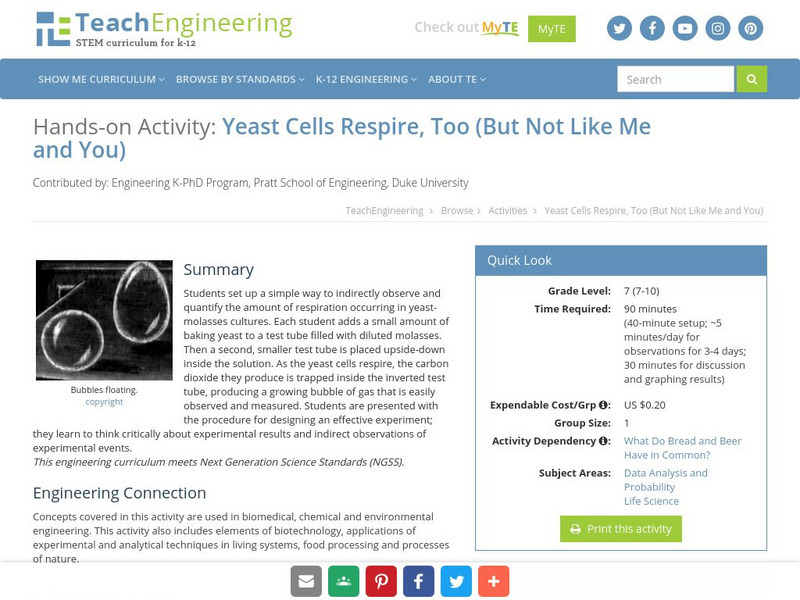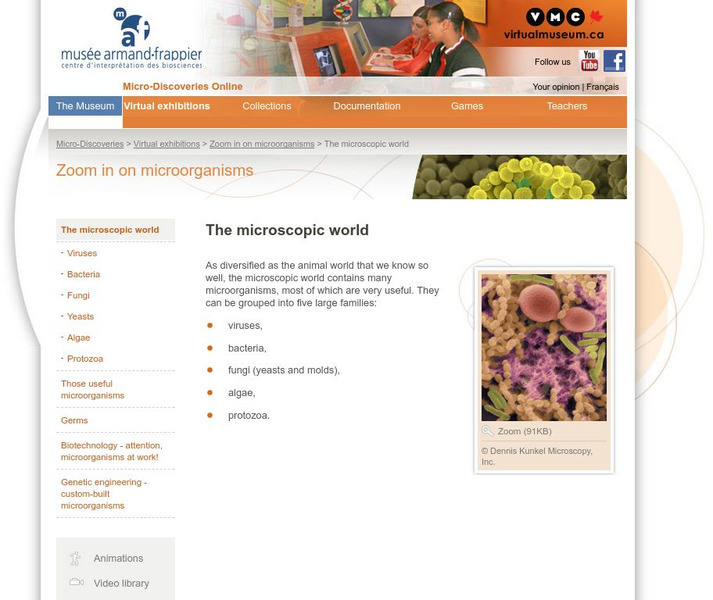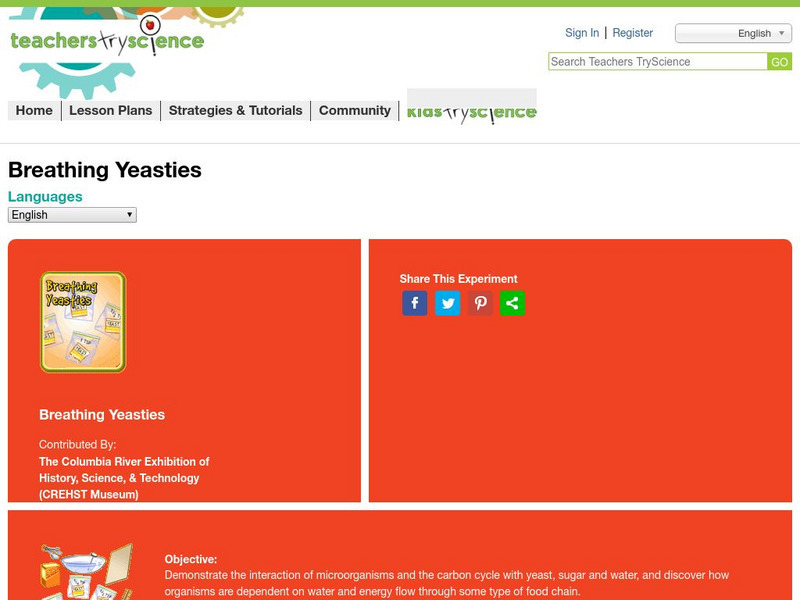Khan Academy
Khan Academy: Cell Cell Signaling in Unicellular Organisms
Article takes a look at how unicellular organisms "chat" with one another using chemical signals. It examines yeast mating types, bacterial quorum sensing, and biofilms.
TeachEngineering
Teach Engineering: Microbes Know How to Work!
Students design systems that use microbes to break down a water pollutant (in this case, sugar). They explore how temperature affects the rate of pollutant decomposition.
TeachEngineering
Teach Engineering: Cellular Respiration and Population Growth
Two lessons and their associated activities explore cellular respiration and population growth in yeasts. Yeast cells are readily obtained and behave predictably, so they are very appropriate to use in middle school classrooms. In the...
TeachEngineering
Teach Engineering: What Do Bread and Beer Have in Common?
Learners are presented with information that will allow them to recognize that yeasts are unicellular organisms that are useful to humans. In fact, their usefulness is derived from the contrast between the way yeast cells and human cells...
TeachEngineering
Teach Engineering: Population Growth in Yeasts
This lesson is the second of two that explore cellular respiration and population growth in yeasts. In the first lesson, students set up a simple way to indirectly observe and quantify the amount of respiration occurring in...
Science Museum of Minnesota
Thinking Fountain: Making Mold
Thinking Fountain, from the Science Museum of Minnesota, offers a project in word and picture. With everyday items, you can grow your own mold, both bread mold and penicillin!
Exploratorium
Exploratorium: Bread Science
From Chinese baozi to Armenian lavash, bread comes in thousands of forms. Find out, on the most basic level, what chemistry ties them all together.
National Institute of Educational Technologies and Teacher Training (Spain)
Ministerio De Educacion: Microbiologia 2 Bachillerato
This unit will allow you to have a broader idea about microorganism, people and the ecosystem. It contains 16 interactive activities.
University of Missouri
Microbes in Action: Classroom Activities: Transfer of Diseases
A science experiment to observe how microbes are transferred by hand contact. This lab creates a model to show students how microbes transfer disease. One student will rub their hand with candy soaked in a yeast solution, then students...
Bio Topics
Bio Topics: To Show the Effects of Temperature on Fermentation by Yeast
In this classroom lab experiment, students measure the effects of temperature on yeast growth and reproduction.
Bio Topics
Bio Topics: To Monitor the Progress of Fermentation of Different Sugars by Yeast
In this classroom lab experiment students measure progress of sugar fermentation by yeast using a hydrometer.
Bio Topics
Bio Topics: Demonstrate the Effect of Temperature on Fermentation by Yeast
Using grape juice as the yeast's food, this lab experiment allows students to test the effect of temperature on yeast fermentation.
TeachEngineering
Teach Engineering: Yeast Cells Respire, Too (But Not Like Me and You)
Students set up a simple way to indirectly observe and quantify the amount of respiration occurring in yeast-molasses cultures. Each student adds a small amount of baking yeast to a test tube filled with diluted molasses. A second,...
Other
Armand Frappier Museum: Micro Discoveries Online: The Microscopic World
This comprehensive exhibit focuses on the wonders of microorganisms, what they are, how they can affect our daily lives, and how they can be manipulated. Videos, games, and animations are included. Teacher resource link explains each...
Andre Dollinger
Reshafim: Bread, the Staff of Life
A look at the preparation of flour and the baking of bread in ancient Egyptian kitchens. Bread, the staff of life, was vital to all classes of Egyptians.
University of Missouri
Microbes in Action: Classroom Activities: Simple Staining of Microbes [Pdf]
With this simple stain, students can observe the shape of yeast and bacteria under the microscope. Lesson plan gives a lab procedure, teacher instructions, points for discussion, and additional activities. Lab does require the purchase...
Teachers TryScience
Teachers Try Science: Breathing Yeasties
See how combining yeast, sugar, and water can demonstrate the carbon cycle and show how microorganisms work in the food chain.
Bryn Mawr College
Serendip: Is Yeast Alive?
Brief text summary of what students learn in the Is Yeast Alive? Lab, along with links to download Student Handouts and Teacher Preparation Notes in PDF or Word formats. Characteristics of life are addressed and metabolism and the...
Alabama Learning Exchange
Alex: Observation of Yeast Growth
In this lesson students will observe the growth of yeast cells, which is evidence that yeasts are converting food to energy and are living organisms.
CK-12 Foundation
Ck 12: Life Science: 6.7 Fungi
Explore the characteristics and classification of fungi.
Exploratorium
Exploratorium: Science of Cooking: Bread Science and Facts
Find out the science behind making bread. This site from Exploratorium turns your kitchen into a lab and you can do much more than bake bread. Do experiments with yeast, and find out what is so exciting about gluten.
Bio Topics
Bio Topics: Yeast Cell Structure
Learn about the structure, size, and uses for yeast in this reference article.
Bio Topics
Bio Topics: Direct Observation of Yeast Population Growth
In this classroom lab experiment, students mimic optimal growth conditions for yeast, and with the help of a microscope, observe and record results using a cell counting method.





















